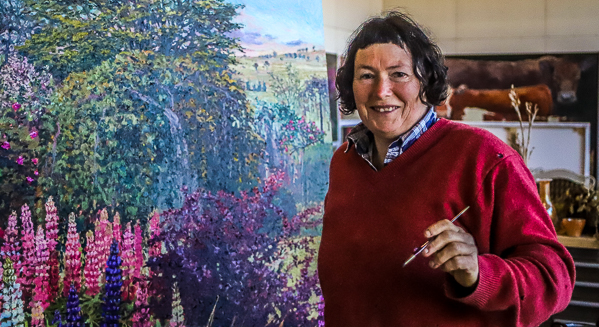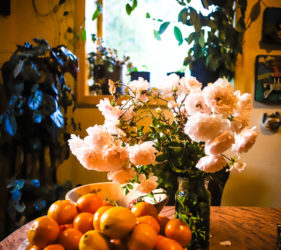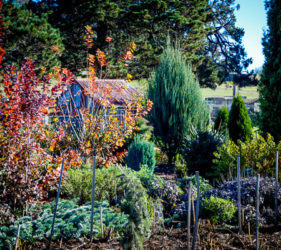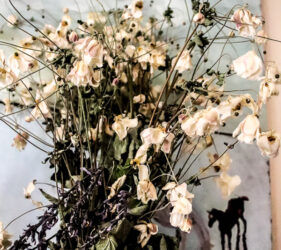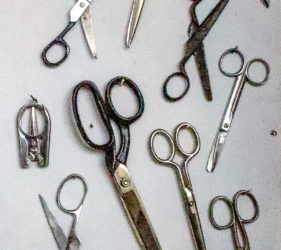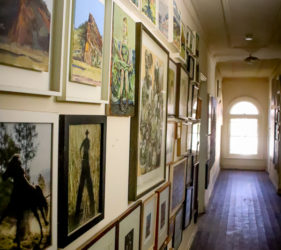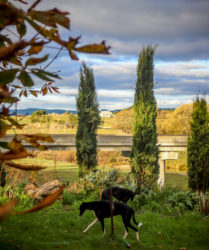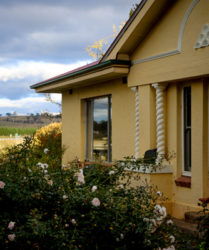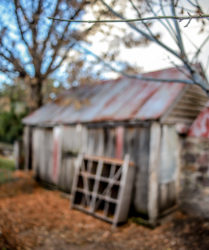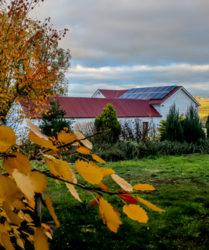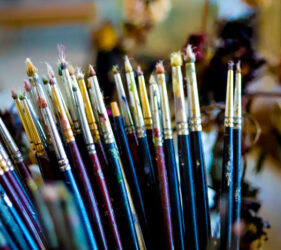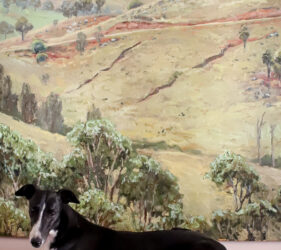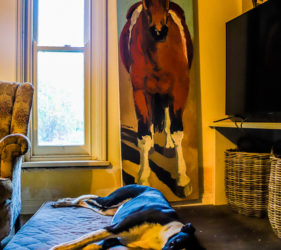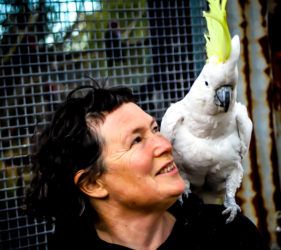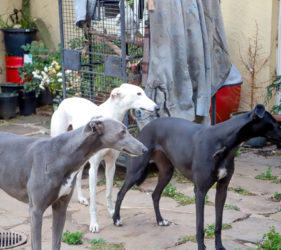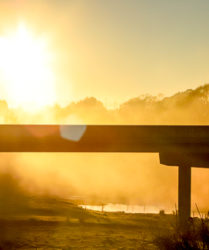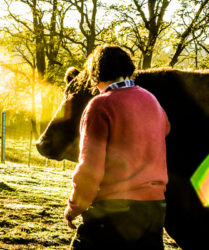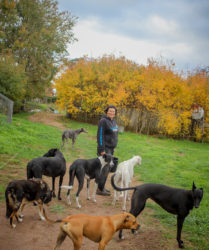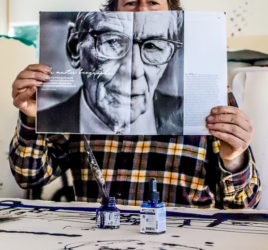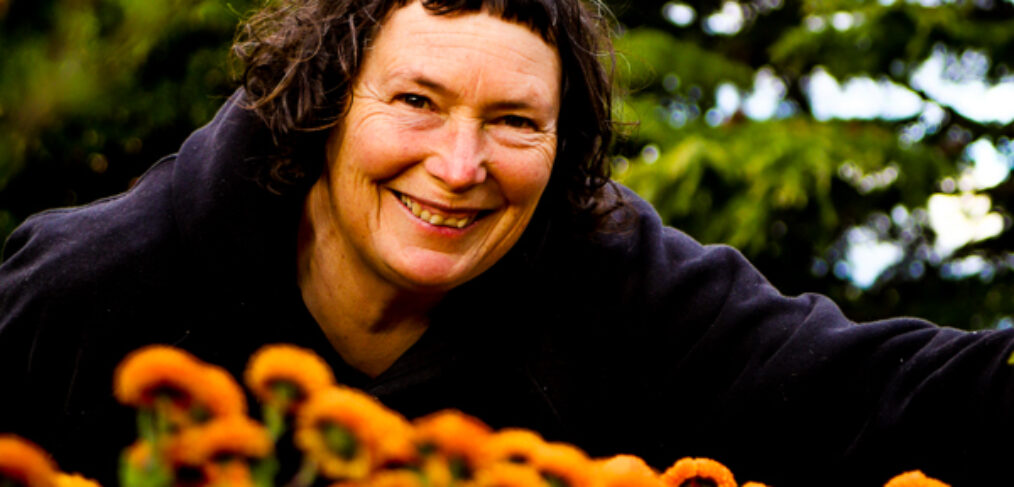
The painted world of Bibbenluke
Lucy Culliton
Story originally appeared in Oz Arts Magazine
Lucy Culliton collects things. She collects doilies and dahlias and flowers in vases that dry out and make shadows on the mantlepiece. She collects emus and other people’s pigs and pigeons; horses in paddocks; and greyhounds on couches who lounge around the fire in winter. She collects paintings and gifts from sisters and grandmothers. Pencils. Scissors and succulents. Hand knitted toys. All of those kinds of things.
 Perhaps it is they that collect her, all of these things, so that they, like everything else at Bibbenluke Lodge – Lucy’s home high up on the Monaro plains – can be rendered in buttery oils and grafted to the immortal, in an endless story of life collecting itself on canvas.
Perhaps it is they that collect her, all of these things, so that they, like everything else at Bibbenluke Lodge – Lucy’s home high up on the Monaro plains – can be rendered in buttery oils and grafted to the immortal, in an endless story of life collecting itself on canvas.
Every piece Culliton paints, the same as everything she collects, is part of a story. Like the pigeons gathered in a group portrait, hanging next to a Ben Quilty piece in the lounge. She painted the birds after she inherited the flock from a guy who passed away and his wife went out of the business of homing pigeons. She collected the Quilty after he came to stay at Bibbenluke.
The sheep which decorate the hill behind the lodge have been freed to live out their days in ovine bliss after she rescued them. The rescue cockatoos in the cages near the house; the two year old albino tadpole in the fish tank; and the enormous steer in the south paddock hand raised by Lucy, all of them have a story, of how they came to be here, and the fates they escaped, on their journey to a place where the “farm animals” will be spared from slaughter by their vegetarian host. The farm dogs are let off their chains for the first time, the greyhounds are spared from racing, and all are lovingly cared for once they arrive. And painted. If you’re living at Bibbenluke, eventually, you are going to be painted.
“I only paint things that are mine,” Culliton says. “So if you brought me some flowers, I’d paint those. But I wouldn’t paint flowers that don’t belong to me.”
Perhaps a sense of belonging is key to her work. The family portraits, of sheep, horses, doves and other creatures fill the walls of her home. Human family members are represented at Bibbenluke by the things they have given to Lucy. She catches sight of one of her collections and unfolds the tale of how each artefact came to belong in the home she shares with her partner Jamie, an earthworks man from round Bombala way.
The begonias in the kitchen may be from her grandmother, the wooden puppet may be from her sister whom she shared a house with in Surry Hills, while Lucy was working as a graphic artist a Taronga Zoo and the Powerhouse Museum.
Artists who commence their careers as graphic artists might credit their commercial beginnings with an eye for structure, balance, flow, shape. Lucy credits her graphic arts origins with a good work ethic.
“I mean you could say of course it helped me to mark out positive and negative space.” But the discipline to stick to a work ethic is the primary gain. “It gave me the sense of having to be organised and having to have a space to live and work,” she says, unlike the students who attended art school with her and supported themselves by working in cafes and other odd jobs, who didn’t have the background of commercial pressures with tight deadlines and clients to please.
It’s a discipline that has paid off well. By 5.45am Jamie is up and ready for work around the Bombala region. By 6 Lucy joins him for a cuppa before Jamie is out the door. At 6.30 she’s out in the paddocks to begin her rounds, feeding the extended family. By 9 she’s at the easel, ready to start her work day. Not just some days, or the days inspiration takes her, but every day. And every day she greets the newness of the oils and her subjects as if seeing them for the first time. Her playful gaze translates to a freshness in her work, which, although rendered with technical perfection in every detail, offers a lively, unpretentious innocence, much like Lucy herself, who is about as down to earth and unaffected by her success as it is possible for any human to be. More than anything, she is simply a natural. Her natural self and her natural, confident ability shines through her smile as much as it shows up on the canvas. In the words of Randi Linnegar, Director of King Street Gallery, Lucy Culliton is an artist of exceptional natural talent with a visual aesthetic that pays heed to no style or preconceived ‘ism’. “Her layering of colour and application of paint shows a strength of confidence in her abilities that will carry her imagery into the next millennium.”
At art school she drew only horses, avoiding, as she says, that terrible imposition on artists arising from academic study: writing essays. “You don’t write essays to explain your music,” she says. The style of study which steered away from the academic pursuit allowed her to escape the dyslexia that destroyed her career as a graphic artist. “I mean, I’m just not very good at it. I would end up laying down bodies of text with incorrect info. So to be able to go to art school and have the freedom to just paint was a blessing.”
After those art school horses blew through the open paddocks of her psyche and she finally gave up graphics for fine arts, she bolted through a collection of material from archetypical Australian landscapes and cup cakes, coat hangers and spark plugs, to cacti and dogs and self portraits, and now, in the current exhibition, her eye is lost in a romance with the gardens she has planted herself in at Bibbenluke.
“I plant to paint”, Culliton says, explaining how the garden beds are planned and planted according to the seasonal views she wishes to paint. The dahlias that splurged their colour all over a reclaimed rocky outcrop of Monaro boulders at the bottom of the top paddock are already smashed by the frost when OzArts arrives, and although the black mush is all that remains of their splendour, the vision still blazes in her eye.
She is roasting chestnuts from someone’s farm in the kitchen, talking about cheese and drinking beer. “I don’t eat animals,” she says. “So it is rennet free cheeses only for me.” She is not a vegan, and doesn’t expect her nine rescue dogs or her partner Jamie to be either.
Jamie gets the job of burying a sheep that has jumped the paddock to heavenly pastures during the night; but it’ll have to wait until he’s home from work. He leaves in the morning before the pre dawn light illuminates the darkest peaks behind the house. His ute rattles along as the sun rises up out of the ocean to the east, cleaving its way over the rainforests on the escarpment. It sends a melting glow over the shimmering frost that claimed the Monaro plains overnight, reaching out as it heads over to touch the shadows of the Snowy Mountains.
It was all gold rush excavation in the pioneering days, those heady days between ancient occupation and whatever the Monaro is now – largely sheep farms and sparse, open country, with barely any patches of trees, though there is an old stand of trees out behind the lodge, remnant bushland that’s just come on the market, and Lucy would love to get her hands on it. “To save the birds,” she says. “I’d just die if someone bought it and we lost all of that.”
There’s no danger of her beloved trees succumbing to the local lumber trade, they’re too stout and spindly, no good for anything saleable, but they would make a perfect wild space for what little wildlife remains. So much has changed since those pioneering days, though the Monaro was always open country, collecting both cold and heat in equal measure at opposite ends of the calendar.
The original lodge was pulled down and carted off to Ballarat in the next gold mining boom. Pulled down, moved, rebuilt, the story of old ways, like half the old houses in other old towns, in a different era to today when countless landscapes are required to fulfil the endlessness of human consumption, and fresh timber is cheaper than human labour. If we were more resourceful Lucy would have more hope for the wildlife she loves. Her own values though, are very much aligned with preserving the old and reusing what we already have. Her entire art studio at Bibbenluke was a building from somewhere nearby that was due to be trashed; Lucy was asked if she would like to keep some of the old weather boards. Instead she took the entire shed, creating a purpose build art studio of aircraft-hanger proportions, with an entire south west facing wall made from double glazed windows that look upon the plains, catching every drop of delicious autumn and winter light – the perfect indirect natural light in a studio designed for any sized work. She paints only in oils, making sure the paints are carefully covered in cling wrap to preserve them for the next morning’s session. “I’m a neat freak,” she says, when it comes to protecting her dogs from any risk of accidental contamination with paint. The dogs roam freely inside and outside the studio, with buckets of water and luxuriating lounges and giant dog mattresses scattered throughout the lodge and the studio, to ensure the comfort of her rescue greyhounds and their four legged pals. “We’re full,” she says. “With seven dogs, we are full. I can’t take any more dogs now.” And then the next month, she welcomes two more, when she takes her father in law’s two retiring farm dogs and lets them roam free, for the first time in their lives.
Lucy collects things. From her time in the Surry Hills terrace she shared with sister Anna, a prolific ceramicist, she collected succulents which are now assembled in a hot house at the rear of her drawing room off, the studio. The room has the same array of plush chairs as the studio, placed conversationally in the centre of the large room. Behind here is a packing room where all of Lucy’s work is racked, filed and archived. We go in to see some of the self portraits with animals series, an earlier phase that is now exhausted, with every angle explored. That exhibition, that phase, that period. But the packing room is so neatly stacked and filed we don’t disrupt the “neat” and take them out. Her smaller works are oil on board, but once the works reach a certain size, the board is switched for canvas, simply so she can move them about. The largest works take up half a massive wall, with a dozen of Lucy’s sheep peering out at you, face on, like a Brady Bunch styled assemblage of faces, all neatly stacked on top of each other. It’s a little like a school photo array. Individual lamb portraits, then the class shot, where all the faces look out to meet your eye straight on, stacked on top of each other. Each is painted individually, one at a time, until the portrait is complete.
Some works are signed, others are not. Identity and ownership don’t appear particularly on top of mind for this established Australian artist.
The paintings begin with the plantings. Planting to paint, she calls her gardening style, which culminates in an explosion of colour that erupts into the garden, as the warmth of summer brings the symphony of colour to its riotous capitulation. And then, when it is all at its peak, she paints it. By winter she’s painting from photographs, the season has outrun her work, and all the colours have shot through to the dank of fall, tinted with autumn turns, as robust as the rooster’s comb, as hot red as the raging fire at the hearth, which warms Lucy, Jamie, her guests, her dogs, the white tad pole in the tank; the spent flowers from the previous painting session which now have a residency on the mantle.
Lucy doesn’t take commissions. She paints to an annual exhibition based around a theme. “If I took commissions I would need to go back to that previous style and do dozens of works of cows. I’d need do a whole heap of cow paintings to get back in the flow, so no, I don’t take commissions unless they let me just paint whatever I like.”
The exception at times, is portraits. “I accepted a commission from Sam Neill – but I had a lot of people waiting for me to do portraits, so I lined them all up and did them before I did Sam’s. He took 3 paintings.”
Amongst her collection of portraits Lucy also has painted Jamie, and her self, usually with her animals. In fact all of her animal work is portraiture too – the crows, the roosters, the emus, the steer, the horses, the pig, the the ducks, the lambs, the cockies. They’re all part of the family, and their needs are as important to Lucy as the needs of any human. Lucy built a large cage to release her cockies, but they were so aggressive with one another they had to go back into their cages. The flowers and paints and the cockies and the canvases all become part of the family. The kitchen windows are filled with her paternal grandmother’s hoyas, and the begonias, they too are family heirlooms, sitting next to the collection of works by her sister, and an old wooden horse puppet, also a gift from her sister.
Lucy collects things, crocheted dolls, the kind you find in CWA markets, all crammed inside a glass display cabinet. She collects puppets and paintings and plants, she collects flowers in vases on window sills. The fire place holds a collection of horses, painted above their shadows on a blue background, hidden behind the decaying flower arrangements on the mantle.
“My work has changed over the years”, she says. “It’s neater. It’s not as rough”.
The view from the guest room falls out the window to the bridge, and straight around to the Hartley scene, cascading from the sky over the hills and into the treetops in the foreground. It could be another window, but it’s an early work, from around 2012, at her parents place in Hartley, from a series that came before she told her sister she needed her share of the Surry Hills terrace so she could buy Bibbenluke Lodge. And she’s filled it up, filled it with animals, and flowers, filled it with love and light and friends.
The chairs need upholstering. A trip up the coast to a friends’ will get the job done. But that would mean stepping outside of Bibbenluke, for more than just a lunch trip. And so the journey is delayed, the chairs remain un-mended and fraying at the edges, as they await the day when Lucy leaves the lodge.
Lucy collects things. She collects paintings of flowers in vases on doilies on dark coloured backgrounds. She collects reasons at Bibbenluke, reasons why she will never have to leave her lodge inside her painted world of Bibbenluke.
Bibbenluke Botanicals runs 9 July to 3 August at King St Gallery
